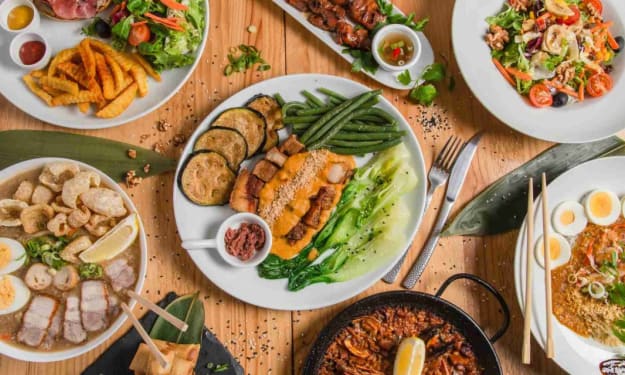
Skilled kitchens need to deliver steaks quickly and reliably to meet objective ticketing times? A measure of time between the chef accepting the request and your table. Casual cafes usually have a ticket time of 20 minutes per course in all cases, although first-class bases may have ticket times of up to 45 minutes, as each course usually requires more procedures.
A first-class food or easy-going chef uses every tool in the book to adjust quality and speed. The stovetop accomplishes this. Gourmet experts often use the broiler finish procedure for fillets and thick-cut steaks (3/4-inch to 2-inch thick), which, when they are sautéed, dry out on the outside before they dry out on the inside. This is also a way you can make steak-quality steaks at home.
Title
Heat the broiler to 450º F. Remove the steaks from the cooler while the broiler is heating so they are near room temperature
Heat 2 tablespoons of vegetable oil in a stovetop-safe sauté container over medium-high heat for a few moments. Season steak with legal salt and freshly ground black pepper.
Place the steak in the container. Sear the steak on both sides until it develops a rich, bright, earthy tone, about 2 to 3 minutes per side. Use utensils to turn the meat.
Transfer the plate to the broiler. One-inch steaks usually take about 6 to 7 minutes to reach the medium uncommon position, while 1 to 1 and 1/2-inch steaks take about 10 minutes. Use a slice reading thermometer to quantify the doneness of the steak.
Genius Tip: Pans
Seasoning a dish, also known as a basting process, requires more skill than a broiler finish, but cook the steak carefully and take into account the spices and spice mixture.
You'll find most of the dish seasonings used in high-end cafes that provide excellent cuts, such as premium bone-in rib eye and porterhouse.
Does container seasoning need to be closely and consistently considered for steaks? Throughout the cooking process, you'll be spooning margarine over the meat. To benefit from a first-class steak, you need to salt and age it for 24 hours, then place it on a shelf in the refrigerator. This? s a fix? steak, giving it some extra flavor and a deeper prepared taste. If you don't have the energy to marinate it 24 hours in advance, season the steak shortly before cooking.
Consider using quality spices to add uncomplicated flavors to the steak. For example, can you "infuse" it? Once you start cooking, add a twig or two to the margarine to create a rib eye with rosemary or thyme pith. A 12-inch cast iron or heavily lined treated steel container is best for this process.
Caption
Remove the steak from the cooler and wipe off with paper towels. Let steak rest for about 30 minutes; steaks that are near room temperature burn and cook more evenly than cold steaks.
Heat 2 tablespoons of vegetable oil in a pan over high heat until you see a wisp of smoke. Place steak in container.
Sear steak on both sides until it takes on a pale, bright, earthy tone. Reduce the temperature to medium.
Add 3 to 4 tablespoons of margarine and any desired spices to the pan. Using a spoon, handle the steak with the pan and margarine, turning it occasionally. You may need to tilt the container toward you to collect the margarine in the spoon.
For medium rare steaks, cook for 8 to 10 minutes, handling and turning as often as possible, or until the internal temperature measures about 125º F. Remove the steak from the container and let it rest for 5 to 10 minutes before serving.
Expert Tip: Searing and Grilling
Singing and searing techniques improve the economy of survival, two of the main elusive features of a very proficient kitchen. It is normal for a rôtisseur or a line cooking expert in charge of cooking to keep a similar recognition of all the movements, moving the steaks from the reach position to the grill and then turning 180º F to place them in the help window.
For this reason, cafe grills, also known as lizards or melts, are usually located within reach? By moving the hot pan to the oven at the opposite stop, there is no threat of cannibalism with the hot pan. In addition, by using it steadily and preheating it, the actual container stays hot throughout the dinner administration, making the process a constant saver.
You'll need a 12-inch cast-iron skillet or hardened steel to find the golden procedure, as will a thermal mat or thick kitchen towel. Filet mignon, rib eye, prime rib and strip steaks at least an inch thick respond well to this technique.
Bearing
Remove steaks from the refrigerator and let stand at room temperature for about 30 minutes. Set the oven rack 4 to 6 batches below the oven grill.
Start the oven and heat the skillet below for about 20 minutes. Rub both sides of the steak with vegetable oil and season with real salt and freshly ground black pepper.
Remove the container from the broiler and place it in the oven on high heat. Using utensils, transfer the steak to a plate. Sear the steak for 30 seconds on each side. Transfer the skillet to the broiler.
For medium rare, sear steaks 2 minutes per side and remove from oven. For medium rare, cook steak 2 minutes longer on each side. Allow steaks to rest for 5 minutes before serving.
Ace tip: Vacuum cooking at low temperatures
Very good quality cafes usually have at least one submerged circulator for cooking the vacuum low temperature cooking method, which is intended for cooking vacuum-fixed food varieties in a hot water shower that maintains a steady temperature. To a large extent, the most gentle cooking strategy, the vacuum low temperature cooking method prevents overcooking and takes into account the high level of flavor infusion through vacuum fixation.
Commercial immersion circulators and cryocoolers? A modern evaluation of vacuum sealers used in restaurants ? Each costs about $2,000, which does not fully clarify the key marks of a luxury cafe. Without the risk of overcooking or bacterial growth, cafes can cook a piece of meat at 125º F for two hours or more for maximum flavor.
After the vacuum low-temperature cooking method shower, the steak undergoes a brief but firm sear for about 20 seconds on each side, as each cooked steak has a precious caramelization effect. The purchaser-based immersion circulator is about $200, but you can cook restaurant-style vacuum low-temperature cooking method steaks at home with the same equipment you might have now? A huge lined pan and skillet.
Bearings
Find a huge, lined skillet on the oven. Then, fill a giant saucepan about three-quarters full of hot water and place it in the skillet.
Place a thermometer on one side of the pan and lower the test to the water. Add more water, if necessary. Set the oven temperature to medium.
Vary the oven temperature until the water reaches the desired temperature. For medium uncommon, focus on a temperature range of 120º F to 128º F? The searing after cooking will bring the doneness to the desired medium level. For medium steaks, focus on a water temperature of 129º F to 134º F.
Add 2 to 3 tablespoons of soy sauce or olive oil to the rock-solid cooling packet along with any spices or marinades. Next add the steak.
Seal the packet, except for a small portion in the corner, so that air can escape. Gradually lower the bag into the water until the steak is completely lowered, but the zippered compartment is not yet exposed. Trust that the air will disappear and completely seal the bag before placing it in the water.
Cook the steak for one hour to four hours, depending on your desired doneness. Screen the water temperature to keep it within the desired range. Remove the package from the water and eliminate the steak.
Heat about 1 tablespoon of vegetable oil in a frying pan over high heat until it begins to smoke. Using utensils, place steak on a plate.
Grill steak for 20 to 30 seconds on both sides. Allow steak to rest for 5 minutes before serving.
Genius Tip: Olive Oil Poaching
Second, for a clever vacuum low-temperature cooking method, olive oil poaching gives the steak an ultra-fine, smooth texture and implanted olive oil flavor that you can't get from sautéing or grilling. Another strategy used by very high quality restaurants is that olive oil poached steaks cost more and have a significant price increase due to limited luxury.? Poached tenderloin in olive oil? sounds extravagant, but it is in contrast to the profound rub in temperature alone? Instead of heating the oil to 375º F, it is heated to 140º F.
Olive oil is an extraordinary vessel for taste? It is primarily the addition of a few defining spices, aromatics and overall flavor to the oil during the cooking process. You don't need to poach with first-class extra virgin olive oil, but you should use new virgin oil because it improves the flavor of the steak and has more medical advantages.
This method works for any size hamburger. You can even save and reuse the oil. After poaching, allow the oil to cool and filter through a fine mesh strainer held in place by a coarse cotton cloth. Store the oil in a waterproof/sealed compartment in a cool area for up to several weeks.
Title
Pour barely enough olive oil in a large lined pot to cover the steak. Add your desired spices and aromatics and heat the oil to 140º F.
Add the steak to the oil. Cook the steak for 30 minutes or until it reaches the desired doneness? A medium uncommon internal temperature is about 125º F and a medium internal temperature is 130º F.
Remove the steak from the oil and place it on a plate secured with paper towels. Place a tablespoon of vegetable oil in a frying pan and heat over high heat.
When you see wisps of smoke coming from the oil, place the steak in the skillet. Grill the steaks for about 20 seconds on each side. Let the steaks rest for 5 minutes before serving.





Comments
There are no comments for this story
Be the first to respond and start the conversation.